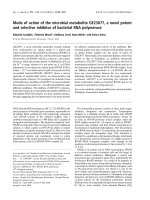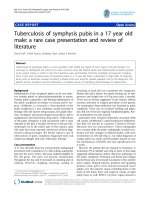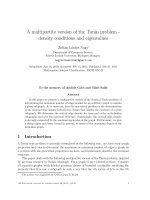Malignant mesothelioma of the tunica vaginalis testis: A rare case and review of literature
Bạn đang xem bản rút gọn của tài liệu. Xem và tải ngay bản đầy đủ của tài liệu tại đây (2.49 MB, 6 trang )
Drevinskaite et al. BMC Cancer
(2020) 20:162
/>
CASE REPORT
Open Access
Malignant mesothelioma of the tunica
vaginalis testis: a rare case and review of
literature
Mingaile Drevinskaite1* , Ausvydas Patasius2,3, Lukas Kevlicius1, Ugnius Mickys4 and Giedre Smailyte2,3
Abstract
Background: Malignant mesothelioma of the tunica vaginalis is a rare tumour which comprises less than 1% of all
mesotheliomas.
Case presentation: 69-years old patient with painful hard mass and hydrocele in the right scrotum to whom a
right hydrocelectomy was performed. Any history of scrotal trauma or exposure to asbestos was not present.
Excisional biopsy revealed a multinodular tumour with focal areas of necrosis and infiltrative growth. According to
morphological and immunohistochemical findings, diagnosis of malignant biphasic mesothelioma of the tunica
vaginalis testis was made. Two months after hydrocelectomy, right inguinal orchidectomy was performed. Postsurgical whole body CT scan revealed paraaortic and pararenal lymphadenopathy, likely to be metastatic. Adjuvant
treatment with 6 cycles of cisplatin and pemetrexed was applied. After 3 cycles of chemotherapy, CT scan showed
progression and the treatment was changed to gemcitabine 1 month after.
Conclusions: Although malignant mesothelioma of the tunica vaginalis is a rare malignancy, it poses a diagnostic
challenge which can mimic common inguinal or scrotal diseases such as hydrocele. Despite aggressive surgical
procedures or adjuvant therapies, the prognosis remains poor.
Keywords: Malignant mesothelioma, Tunica vaginalis
Background
Malignant mesothelioma of the tunica vaginalis testis
(also known as paratesticular mesothelioma) is a rare
tumour, comprising less than 1% of all mesotheliomas
[1, 2]. Since the first record in 1957, only case reports
and case series have been published, with less than 300
patients worldwide to date [3, 4]. The majority of these
cases presented as an incidental finding during hydrocelectomy [4, 5]. Due to the rarity of this disease, epidemiology and risk factors are still unclear, and it is unknown
whether asbestos exposure plays a role in the etiology of
testicular mesothelioma [1, 6]. We present a case of malignant mesothelioma of the tunica vaginalis diagnosed
after hydrocele surgery with a review of the literature.
* Correspondence:
1
Faculty of Medicine, Vilnius University, Vilnius, Lithuania
Full list of author information is available at the end of the article
Case presentation
A 69-year-old man was referred to our hospital after the
right
hydrocelectomy
when
suspicious,
nonhomogeneous tissues were found intraoperatively. Ultrasound imaging and computed tomography (CT) scan
were not performed before the surgery. On physical
examination, right scrotum appeared to be edematous,
hard and painful mass was evident with no palpable
lymphadenopathy. Mentioned symptoms have been observed for a year. The patient denied any history of scrotal trauma or exposure to asbestos. 8 years ago he was
diagnosed with prostate adenocarcinoma (Gleason 3 +
3 = 6) cT1cN0M0 stage II, the result of external beam
radiotherapy (74 Grays / 37 fractions) treatment was
radical. One year due to PSA (prostate specific antigen)
relapse, there were androgen deprivation therapy prescribed. 9 months thereafter androgen deprivation therapy was discontinued due to low PSA rates. To the date
of testicular mesothelioma diagnoses serum PSA level
was 0.1 ng/ml. No other comorbidities were reported to
© The Author(s). 2020 Open Access This article is distributed under the terms of the Creative Commons Attribution 4.0
International License ( which permits unrestricted use, distribution, and
reproduction in any medium, provided you give appropriate credit to the original author(s) and the source, provide a link to
the Creative Commons license, and indicate if changes were made. The Creative Commons Public Domain Dedication waiver
( applies to the data made available in this article, unless otherwise stated.
Drevinskaite et al. BMC Cancer
(2020) 20:162
this patient. Levels alpha-fetoprotein and beta human
choriogonadotropin were not elevated. The excisional
biopsy revealed a multinodular tumour with focal areas
of necrosis and infiltrative growth. Mixed epithelial and
spindle cell proliferation was present. The bulk of the
epithelial component contained confluent cords and
nests of monotonous, ovoid to polygonal cells with pale
or eosinophilic cytoplasm (Fig. 1a). Focally, cell clusters
were scattered in dense fibrous stroma or intermixed
with moderately atypical spindle cells (Fig. 1b). Few glomeruloid structures were noted (Fig. 1c). There was no
distinct transition from epithelioid to sarcoma-like areas
(Fig. 1d). Diffuse immunoreactivity for cytokeratin AE1/
AE3, calretinin, WT1, vimentin and CD10 was seen,
with focal positivity for desmin in the epithelial component and smooth muscle actin in the sarcomatous part.
CK5, EMA, PSA, NKX3.1, CK7, CK20, BerEp4, TTF-1,
Page 2 of 6
Cdx2, Pax8, SALL4, alpha-inhibin, ER, AR, LCA, myogenin were negative. According to morphological and
immunohistochemical findings, diagnosis of malignant
biphasic mesothelioma of the tunica vaginalis testis was
made.
Two months after hydrocelectomy, right inguinal orchidectomy was performed. Paratesticular space was largely replaced with yellow-white nodular masses with cystic spaces
(Fig. 2). The subsequent histological examination confirmed
the diagnosis (Fig. 1e and f). Post-surgical whole body CT
scan revealed paraaortic and pararenal lymphadenopathy,
likely to be metastatic (Figs. 3 and 4). The multidisciplinary
team indicated adjuvant treatment with 6 cycles of cisplatin
and pemetrexed. Three months after initiation of systemic
treatment (3 cycles of cisplatin and pemetrexed), CT scan
showed progression (Figs. 5 and 6) and the treatment was
changed to gemcitabine 1 month after. Seven months after
Fig. 1 Histologic patterns, HE. (a) Nests of immature epithelioid cells, × 20; (b) Sarcomatoid areas mimicking desmoplastic response of the widely
dispersed epithelial cells, × 10; (c) A highly cellular tumour with glomerular-like epithelial tufts projecting into cystic epithelium lined spaces, × 20;
(d) An insidious right-to-left transition from epithelial to sarcomatous components, × 20; (e) Intracystic tumour with paratesticular spread, × 2; (f)
The more-typical tubulopapillary pattern of mesothelioma, × 20
Drevinskaite et al. BMC Cancer
(2020) 20:162
Page 3 of 6
Fig. 2 Resected specimen shows 3 cm × 7 cm nodular masses
encasing the compressed testicular tissue
initiation of systemic treatment, patients status deteriorated
significantly (ECOG – 3), accompanied by unmanageable
pain and patient was transferred to palliative care centre.
The patient died 9 months after the diagnosis.
Discussion and conclusions
Malignant mesotheliomas are uncommon tumours,
which can develop from the coelomic epithelium at the
pleura, peritoneum, pericardium and tunica vaginalis
testis. Mesothelioma of the tunica vaginalis testis represent only 0.3–5% of all mesothelial neoplasms [7]. According to Cancer Registry data in Lithuania 10–15 of
mesotheliomas are reported each year. Since 1978 there
was one patient with pericardial mesothelioma and none
had mesothelioma of the tunica vaginalis testis to this
date.
Testicular mesotheliomas usually occur between 55
and 75 years [5]. According to a population study in the
United States, there were 52 testicular mesothelioma
Fig. 3 Enlarged to 21 × 15 mm infrarenal paraaortic masses in
computed tomography axial view
Fig. 4 Infrarenal paraaortic masses enlarged to 21 × 25 mm, next to
aortic bifurcation masses enlarged to 15 mm in computed
tomography coronal view
cases of 7101 malignant mesotheliomas diagnosed
among males between 1973 and 2013 [1]. The incidence
rate increased with age as males over the age of 80 had
an 18.6 times higher rates than males under the age of
50 [1].
Exposure to asbestos is a major risk factor for the development of pleural and peritoneal mesotheliomas.
However, asbestos link to tunica vaginalis tumours is
not well elucidated [1, 7, 8]. In the literature review by
Mezei et al., among the 89 reported testicular mesotheliomas the possibility of asbestos exposure was considered
for 50 patients (56%) and confirmed or assumed for 30%
Fig. 5 Radiological progression of disease with paraaortic mass,
enlarged to 32 × 28 mm in computed tomography axial view
Drevinskaite et al. BMC Cancer
(2020) 20:162
Fig. 6 Paraaortic mass enlarged to 32 × 28 mm and mass next to
aortic bifurcation, enlarged to 31 mm
[1]. In a general review of 223 cases, Bisceglia et al.
found an association with asbestos exposure in only 30–
40% [9]. The registry study of Marinaccio et al. provided
no direct evidence that testicular mesothelioma was associated with asbestos exposure. The authors report that
there was only one case in the highest risk industries
such as asbestos cement, national defence, shipbuilding
and railway industries [2]. Studies of asbestos exposed
occupational cohorts reported no cases of malignant testicular mesothelioma as well [8]. The patient in our report is a 69-years-old man with no known history of
asbestos exposure. Published literature marks an inconsistent relationship with asbestos and alone do not allow
for any definite causal association to be made.
Other suspected risk factors for the disease include
trauma, herniorrhaphy, long term hydrocele or spermatocele, long-term epididymitis, orchitis or other inguinal
inflammation [1, 3, 4, 7, 10–14]. The mechanism by
which chronic serosal inflammation contributes to the
development of mesotheliomas are not known, although
it has been suggested that they may be mediated via continuous production of interleukin-6 [15]. The patient in
our case report denied any inguinal trauma or inflammation, or other possible risk factors, however, long-term
hydrocele for a year and history of prostate cancer were
evident. The first known study considering longstanding hydrocele and the risk of developing testicular
mesothelioma was published in 2001 [14]. Unfortunately,
there are no analytic epidemiologic studies done to
prove this relation.
Therapeutic radiation for other malignancies is a wellestablished risk factor for pleural and peritoneal mesotheliomas [16, 17]. The etiologic link between ionizing
radiation and malignant mesothelioma of the tunica
vaginalis is plausible, due to radiation therapy causing
Page 4 of 6
multiple types of cancer [1, 7, 17]. It should be noted
that our patient received an external beam radiotherapy
treatment 8 years ago when he was diagnosed with prostate adenocarcinoma. Similar report was published in
2000 by Ferri et al. Their patient was diagnosed with
prostate adenocarcinoma, treated surgicaly followed by
radiation therapy. After 3 years, a pleural seroma, a cutaneous mass and testicular nodule were observed and cytological examination showed endothelial cells. Scrotal
orchidectomy was performed, and further examination
confirmed malignant mesothelioma of the tunica vaginalis
testis [18]. Yet, there are no studies done, except a few reports, to prove the relation between radiation of prostate
adenocarcinoma and testicular mesothelioma [1].
The rarity of testicular mesothelioma poses challenges
to its diagnosis and that is rarely achieved preoperatively.
Main symptoms are nonspecific and patients usually
present with enlargement of the scrotum, recurrent
hydrocele and palpable scrotal mass [19]. Commonly
suspected clinical diagnoses include epididymitis, scrotal
or inguinal hernia and spermatocele [9]. Ultrasonography (US) is non-invasive, simple and 90% accurate
method when used to detect testicular tumours [20].
However, only case series describe imaging features of
testicular mesotheliomas. Bertolotto et al. concluded that
the most common US finding in the majority (5/10) of
their patients was hydrocele with hypervascular parietal
vegetations, while three patients had non-specific solid
masses without hydrocele [21]. In our case, US and
other imaging methods were not evaluated. Even though
preoperative diagnosis could potentially lead to more aggressive surgical approaches and better survival, most tumours are identified intraoperatively on the basis of
hemorrhagic hydrocele fluid, white – yellow nodules or
papillary excrescences of the tunica vaginalis testis,
followed by pathologic examination [2, 19].
In typical cases tunica vaginalis mesotheliomas resemble their pleural and peritoneal counterparts [22]. Pure
epithelioid and biphasic histologic subtypes comprise
60–75% and 20–40% of all testicular mesotheliomas respectively and only few cases of pure sarcomatoid differentiation were identified [23, 24]. The tumour usually
show papillary, tubulopapillary or well-differentiated
solid growth with or without spindle cell proliferation
[22, 24]. However, the wide morphologic diversity is a
well-recognized feature [25]. The most commonly cited
differential diagnosis include carcinoma of the rete testis,
ovarian epithelial-type tumours of testis and paratestis,
secondary adenocarcinomas, adenomatoid tumour and
pleomorphic sarcomas [22, 24, 26, 27]. In our case, the
pre-operative biopsy specimen lacked common features
of mesothelioma, while the sex cord-like appearance (i.e.
uniform low-grade epithelioid cells organized in sheets,
cords, nests with blurred epithelial-stromal interface)
Drevinskaite et al. BMC Cancer
(2020) 20:162
was striking. Sex cord-stromal tumours are rarely mentioned as potential mesothelioma mimics and its histological pattern in the testicular region is prone to
multiple diagnostic errors. This points out that lowvolume paratesticular biopsies should be interpreted
with caution and a wider immunohistochemical panel
could be of major diagnostic value.
There is scarce evidence regarding treatment of this
disease. Therapeutic principles are frequently extrapolated from management of pleural or peritoneal mesotheliomas and may feature a combination of surgery,
radiation therapy and chemotherapy [28]. In our case,
radical inguinal orchidectomy was performed after diagnosis, with radical intent. Although, presence of distant
metastasis was unknown. As inguinal lymph nodes were
not palpable, lymphadenectomy was not indicated [12].
Permetrexed with cisplatin, which have had a proven efficacy in pleural mesothelioma, are most often used in
cases with unfavorable prognosis [29, 30]. Being diagnosed with metastatic disease, our patient received 4 cycles of cisplatin and pemetrexed. However, systemic
treatment appered to be uneffective and gemcitabine
was prescribed as 2nd line treatment. Gemcitabine is a
valid options for patients, who do not respond well to
platinum-based chemotherapy drugs [31]. Higher
tumour stage (tumour, greater or equal to four centimeters, nodal involvement and metastasis) and biphasic
histologic subtype are associated with significantly worse
outcomes of testicular mesotheliomas [23]. More than
50% of patients develop local or distant recurrence with
more than 60% recurrences within the first 2 years (5,19,
29). Long-term follow-up should be assured, as one of
case from study in The Johns Hopkins Hospital reported a
reccurence after 15 years [6]. Of the total of 113 patients
analyzed by Nazemi et al., the reported 5-year and 10-year
overall survival was 49 and 33% respectively [23].
In summary, we present a case of a patient with testicular mesothelioma of tunica vaginalis. The rarity of
testicular mesothelioma poses challenges to its etiology
research, diagnosis and treatment. Diagnosis of testicular
mesotheliomas is challenging, as the tumour lacks specific clinical and radiologic features, and the reported
sex cord-like pattern proves its histological diversity.
Despite aggressive surgical procedures or extratesticular
mesothelioma-based adjuvant therapies, the prognosis
remains poor.
Acknowledgements
The authors would like to thank the patient for his participation and his
consent to the publication of the case details and associated images.
Authors’ contributions
AP, MD designed, performed the study and carried out literature search; AP,
MD, GS and LK helped in literature search and wrote the paper; AP, UM, LK
helped in acquisition and analysis of data; GS made critical revision and
supervision. All authors have read and approved the manuscript.
Page 5 of 6
Funding
No financial support was received for this submission.
Availability of data and materials
All data generated or analyzed during this study are included in this
published article.
Ethics approval and consent to participate
Review board of National cancer Institute approval.
Consent for publication
Written informed consent was obtained from the case patient/family for
publication of this report and any accompanying images. A copy of the
written consent is available for review by the Editor of this journal.
Competing interests
The authors declare that they have no competing interests.
Author details
1
Faculty of Medicine, Vilnius University, Vilnius, Lithuania. 2Laboratory of
Cancer Epidemiology, National Cancer Institute, Vilnius, Lithuania.
3
Department of Public Health, Institute of Health Sciences, Faculty of
Medicine, Vilnius University, Vilnius, Lithuania. 4National Center of Pathology,
Affiliate of Vilnius University Hospital Santaros Clinics, Vilnius, Lithuania.
Received: 9 July 2019 Accepted: 17 February 2020
References
1. Mezei G, Chang ET, Mowat FS, Moolgavkar SH. Epidemiology of
mesothelioma of the pericardium and tunica vaginalis testis. Ann Epidemiol.
2017;27(5):348–359.e11.
2. Marinaccio A, Binazzi A, Di Marzio D, Scarselli A, Verardo M, Mirabelli D, et al.
Incidence of extrapleural malignant mesothelioma and asbestos exposure,
from the Italian national register. Occup Environ Med. 2010;67(11):760–5.
3. Zhang N, Fu N, Peng S, Luo X. Malignant mesothelioma of the tunica
vaginalis testis: a case report and literature review. Mol Clin Oncol. 2017;7(6):
1053–6.
4. Chen J-L, Hsu Y-H. Malignant mesothelioma of the tunica vaginalis testis: a
case report and literature review. Kaohsiung J Med Sci. 2009;25(2):77–81.
5. Jones MA, Young RH, Scully RE. Malignant mesothelioma of the tunica
vaginalis. A clinicopathologic analysis of 11 cases with review of the
literature. Am J Surg Pathol. 1995;19(7):815–25.
6. Brimo F, Illei PB, Epstein JI. Mesothelioma of the tunica vaginalis: a series of
eight cases with uncertain malignant potential. Mod Pathol Off J U S Can
Acad Pathol Inc. 2010;23(8):1165–72.
7. Trenti E, Palermo SM, D’Elia C, Comploj E, Pycha A, Carella R, et al. Malignant
mesothelioma of tunica vaginalis testis: report of a very rare case with
review of the literature. Arch Ital Urol Androl Organo Uff Soc Ital Ecogr Urol
E Nefrol. 2018;90(3):212–4.
8. IARC Monographs Volume 100C Asbestos (Chrysotile, Amosite, Crocidolite,
Tremolite, Actinolite and Anthophyllite) – IARC [Internet]. [cited 2019 Feb
22]. Available from: />00c-asbestos-chrysotile-amosite-crocidolite-tremolite-actinolite-andanthophyllite/.
9. Bisceglia M, Dor DB, Carosi I, Vairo M, Pasquinelli G. Paratesticular
mesothelioma. Report of a case with comprehensive review of literature.
Adv Anat Pathol. 2010;17(1):53–70.
10. Yen C-H, Lee C-T, Su C-J, Lo H-C. Malignant mesothelioma of the tunica
vaginalis testis: a malignancy associated with recurrent epididymitis? World
J Surg Oncol. 2012;10:238.
11. Mrinakova B, Ondrus D, Kajo K, Kunderlik M, Tkacova M, Ondrusova M.
Paratesticular mesothelioma in young age. Case report. Klin Onkol Cas
Ceske Slov Onkol Spolecnosti. 2012;25(4):290–3.
12. Akin Y, Bassorgun I, Basara I, Yucel S. Malignant mesothelioma of tunica
vaginalis: an extremely rare case presenting without risk factors. Singap Med
J. 2015;56(3):e53–5.
13. Maheshwari PN, Abiola OO, Wagaskar VG, Oswal AT. Hydrocele with a
surprise: malignant mesothelioma of the tunica vaginalis - case report and
review of literature. Urol Ann. 2017;9(1):110–2.
Drevinskaite et al. BMC Cancer
(2020) 20:162
14. Gürdal M, Erol A. Malignant mesothelioma of tunica vaginalis testis
associated with long-lasting hydrocele: could hydrocele be an etiological
factor? Int Urol Nephrol. 2001;32(4):687–9.
15. Dostert C, Pétrilli V, Van Bruggen R, Steele C, Mossman BT, Tschopp J. Innate
immune activation through Nalp3 inflammasome sensing of asbestos and
silica. Science. 2008;320(5876):674–7.
16. Attanoos RL, Churg A, Galateau-Salle F, Gibbs AR, Roggli VL. Malignant
mesothelioma and its non-Asbestos causes. Arch Pathol Lab Med. 2018;
142(6):753–60.
17. Humans IWG on the E of CR to. Radiation. International Agency for
Research on Cancer; 2012.
18. Ferri E, Azzolini N, Sebastio N, Salsi P, Meli S, Cortellini P. Unusual case of
mesothelioma of the tunica vaginalis associated with prostatic
adenocarcinoma. Minerva Urol E Nefrol Ital J Urol Nephrol. 2000;52(1):33–5.
19. Plas E, Riedl CR, Pflüger H. Malignant mesothelioma of the tunica vaginalis
testis: review of the literature and assessment of prognostic parameters.
Cancer. 1998;83(12):2437–46.
20. Blaivas M, Brannam L. Testicular ultrasound. Emerg Med Clin North Am.
2004;22(3):723–48 ix.
21. Bertolotto M, Boulay-Coletta I, Butini R, Dudea SM, Grenier N, Oltmanns G,
et al. Imaging of mesothelioma of tunica vaginalis testis. Eur Radiol. 2016;
26(3):631–8.
22. Amin MB. Selected other problematic testicular and paratesticular lesions:
rete testis neoplasms and pseudotumors, mesothelial lesions and secondary
tumors. Mod Pathol Off J U S Can Acad Pathol Inc. 2005;18(Suppl 2):
S131–45.
23. Nazemi A, Nassiri N, Pearce S, Daneshmand S. Testicular mesothelioma: an
analysis of epidemiology, patient outcomes, and prognostic factors.
Urology. 2019;126:140–4.
24. Chekol SS, Sun C-C. Malignant mesothelioma of the tunica vaginalis testis:
diagnostic studies and differential diagnosis. Arch Pathol Lab Med. 2012;
136(1):113–7.
25. Allen TC. Recognition of histopathologic patterns of diffuse malignant
mesothelioma in differential diagnosis of pleural biopsies. Arch Pathol Lab
Med. 2005;129(11):1415–20.
26. Lloreta-Trull J. Extrathoracic mesothelial proliferations and their mimics.
Ultrastruct Pathol. 2006;30(1):37–51.
27. Ghosh P, Saha K. Primary adenocarcinoma of rete testis with distinct
biphasic pattern: an extremely rare entity and diagnostic challenge. J Nat
Sci Biol Med. 2015;6(1):211–3.
28. Yan TD, Welch L, Black D, Sugarbaker PH. A systematic review on the
efficacy of cytoreductive surgery combined with perioperative
intraperitoneal chemotherapy for diffuse malignancy peritoneal
mesothelioma. Ann Oncol Off J Eur Soc Med Oncol. 2007;18(5):827–34.
29. Recabal P, Rosenzweig B, Bazzi WM, Carver BS, Sheinfeld J. Malignant
mesothelioma of the tunica Vaginalis testis: outcomes following surgical
management beyond radical orchiectomy. Urology. 2017;107:166–70.
30. Vogelzang NJ, Rusthoven JJ, Symanowski J, Denham C, Kaukel E, Ruffie P,
et al. Phase III study of pemetrexed in combination with cisplatin versus
cisplatin alone in patients with malignant pleural mesothelioma. J Clin
Oncol Off J Am Soc Clin Oncol. 2003;21(14):2636–44.
31. Favaretto AG, Aversa SML, Paccagnella A, Manzini VDP, Palmisano V, Oniga
F, et al. Gemcitabine combined with carboplatin in patients with malignant
pleural mesothelioma: a multicentric phase II study. Cancer. 2003;97(11):
2791–7.
Publisher’s Note
Springer Nature remains neutral with regard to jurisdictional claims in
published maps and institutional affiliations.
Page 6 of 6









